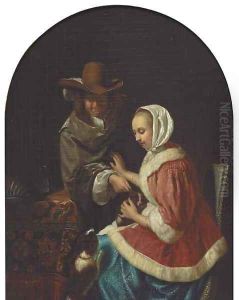Frans Van The Elder Mieris Paintings
Frans van Mieris the Elder was a pivotal figure in the Dutch Golden Age of painting, born in the city of Leiden, Netherlands, in 1635. He emerged from a lineage of artists and was particularly renowned for his finely detailed genre scenes, portraits, and history paintings. Van Mieris was a student of Gerrit Dou, who was a master of the Leiden School and a pupil of Rembrandt. This connection placed Van Mieris at the heart of the development of the fijnschilder (fine painting) technique, characterized by its meticulous attention to detail, smooth finish, and vibrant realism.
Van Mieris's work was highly sought after by collectors during his lifetime, and he enjoyed considerable success. His paintings often depicted everyday scenes imbued with a sense of intimacy and warmth, showcasing his ability to capture textures, reflections, and the interplay of light and shadow with exceptional skill. Beyond genre scenes, he also excelled in creating tronies (character studies), allegorical works, and historical scenes, demonstrating versatility and a deep understanding of human nature and emotions.
Despite his achievements, Frans van Mieris the Elder led a life marked by personal tragedy, including the loss of several children at young ages. These events, however, did not diminish his artistic output or the quality of his work. He was a significant influence on subsequent generations of painters, including his own son, Frans van Mieris the Younger, who followed closely in his father's footsteps.
Van Mieris's legacy is enduring, with his works held in high esteem and featured in major museums and collections worldwide. He passed away in 1681 in Leiden, leaving behind a body of work that continues to be celebrated for its refinement, technical skill, and the window it offers into the world of the 17th-century Dutch Republic. His contributions to the Dutch Golden Age and the art of painting are remembered as an important link in the chain of European art history, bridging the gap between the Baroque and the Enlightenment.
